Hydrophilic Interaction Chromatography (HILIC) for Simultaneous and Fast Analysis of Melamine, Cyanuric Acid, Ammeline, and Ammelide in Milk and Infant Formula
Since melamine and its metabolites are extremely polar compounds, they serve as very good candidates for HILIC chromatography. Simultaneous and fast determination and confirmation of melamine and cyanuric acid along with two other compounds using a novel amino bonded phase in HILIC mode coupled with a complete solutions approach is presented.
Eugene Chang1 , David, Ji2 , and Ritu Arora1 ,1 Varian, Inc. and 2 Analytical Laboratories in Anaheim, Inc.
Since melamine and its metabolites are extremely polar compounds, they serve as very good candidates for HILIC chromatography. Simultaneous and fast determination and confirmation of melamine and cyanuric acid along with two other compounds using a novel amino bonded phase in HILIC mode coupled with a complete solutions approach is presented.
This application note provides simultaneous determination and confirmation of melamine, ammelide, ammeline, and cyanuric acid in a reliable, efficient, and rapid LC–MS-MS method. The US FDA method (1) for melamine and cyanuric acid was followed with some modifications made to establish a method for all four compounds.
Instrumentation, Materials, and Reagents
- Varian 320-MS Triple Quadrupole Mass Spectrometer with ESI source. Varian 212-LC binary gradient pumps and Combi PAL™ autosampler.
- SPE cartridge: Bond Elut Plexa, 60 mg, 3 mL cartridge, (Varian Part Number 12109603).
- Melamine (MEL). CAS #: 108-78-1 Ammelide, CAS #: 645-93-2, Ammeline CAS #: 645-92-1 and Cyanuric acid (CYA). CAS # 108-80-5; ChromaDex Inc., California.
- Milk, "organic" milk, 100% from local deli store.
- Infant formula, a popular brand, concentrated, milk-based formula from local grocery store.
Procedure
Sample preparation procedure was based on US FDA's method (1), modified with an additional filtration step with Bond Elut Plexa™ SPE cartridge before the last step. Instead of transferring the filtrates for injections, condition Bond Elut Plexa™ 60 mg, 3 mL SPE cartridge (Varian Part Number 12109603) with 3-mL acetonitrile. Then, transfer the supernatant of the centrifugation step to clean-up each sample, collect the filtrate in 2-mL sample vials for injections.
LC Conditions
Column: Varian Polaris™ NH2, 5 µm, 150 x 3 mm (Varian Part Number A2013150X030)
Mobile Phase: A: Acetonitrile, B: Ammonium acetate 10 mM and 0.1% glacial acetic acid in water (both A and B are in separate lines)
LC Program: 78% A isocratic, 0.4 mL/min
Column Temp.: 40°C
Injection Volume: 20 µL
Instrument: Varian 320-MS Triple Quadrupole Mass Spectrometer
Ionization Mode: ESI Positive/Negative
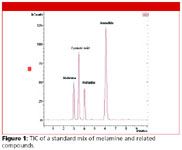
Figure 1
Results and Discussion
LC separation: Melamine and related compounds are extremely polar compounds as seen by their log P values in Table I and serve as good candidates for HILIC chromatography. All four compounds, having either basic or acidic properties can be analyzed simultaneously in a single run on an amino bonded phase like Polaris NH2 in HILIC mode. Separation of this mix is essential as some of the isotope peaks can interfere with each other (Table I). Figure 1 shows a total ion chromatogram with baseline separation of all four analytes within 7 min. Concentration of aqueous modifier in HILIC plays an important role as it directly affects solvent strength. If there is too much water, cross-over into other modes of chromatography can take place, depending on the analyte and phase, i.e. separations begin to look like IEX or RP (IEX most likely with NH2 phase). Upon investigating this effect on Polaris NH2 using a mix of melamine and related compounds, reproducible chromatography was attainable between 15%–30% aqueous modifiers (70%–85% organic concentrations) (2). Figure 2 demonstrates robustness of Polaris NH2 for the analysis of melamine and cyanuric acid standards after 1500 injections, the column being used for routine analysis of these compounds in milk powder, soybean powder, and snack food using the US FDA method (1). As seen, the retention times, reproducibility, and resolution between melamine and cyanuric acid are consistent after over a thousand injections.
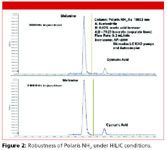
Figure 2
Matrix impurities removal: A major modification to the published U.S. FDA method (1) is the inclusion of a clean-up step after dilution of sample extracts with ACN in the sample preparation protocol. Bond Elut Plexa is used as a clean-up filter to retain matrix interferences while all the polar analytes pass through. Figure 3 demonstrates a comparison of chromatograms of ammelide in fortified milk sample before and after clean-up. Impurities at the front end are completely removed after the extracts are passed through a clean-up filter.
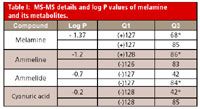
Table I: MS-MS details and log P values of melamine and its metabolites.
Calibration range and sensitivity: Both matrices, milk and infant formula, are fortified with concentrations of 0.25, 0.5, 1.0, 2.5, and 5.0 µg/g of melamine and related compounds. The signal-noise ratio at the lowest concentration of 0.25 µg/g is 16 or higher, which exceeds the specification of U.S. FDA specification of 5 or higher (1).
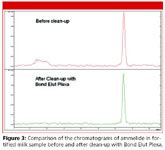
Figure 3
Linearity and recoveries: Five point calibration curves were generated with good linearity in the range of 0.25 to 5 µg/g, with linear regression coefficient r2 higher than 0.99 (3). Recoveries of melamine and cyanuric acid observed are in the range of 84%–95%. For ammeline and ammelide, the recoveries are in the range of 68%–89%. RSDs observed were below 20% for all sample sets (3).
Conclusions
Simultaneous, fast determination, and confirmation of melamine, ammeline, ammelide, and cyanuric acid in milk and infant formula using a complete solutions package comprising Varian Bond Elut Plexa™, Polaris™ NH2, and 320-MS was achieved. Polaris NH2 column can be used in HILIC mode with ease for both basic and acidic compounds. It offers baseline separation within 7 min for all four compounds. Column robustness and longevity is proven for melamine and cyanuric acid standards screened in milk powder, soybean powder, and snack food for over a thousand injections. Bond Elut Plexa serves as an effective clean-up filter by retaining matrix interferences and allowing polar analytes to pass through.
References
(1) Determination of Melamine and Cyanuric Acid Residues in Infant Formula using LC-MS/MS, Sherri Turnipseed, Christine Casey, Cristina Nochetto, David N. Heller. FDA Laboratory Information Bulletin, LIB No. 4421, Vol24, Oct 2008 http://www.cfsan.fda.gov/~frf/lib4421.html
(2) Effect of Stationary Phase Chemistry on Selectivity of Pharmaceuticals, Pesticides, and Oligosaccharides in HILIC Separations, Ritu Arora, Richard Robinson, Mike Chang, Eugene Chang, Poster #: 600-5P, Pittcon 2009.
(3) Simultaneous and Fast Analysis of Melamine, Cyanuric Acid, and Related Compounds in Milk and Infant Formula by LC/MS/MS, Eugene Chang, Ritu Arora, Varian Application Note SI-01916.
Acknowledgements
Data on column robustness provided by David Ji, Laboratory Director, Analytical Laboratories in Anaheim, Inc.

Varian, Inc.
25200 Commercentre Drive, Lake Forest, CA 92630
tel. (949)770-9381, fax (949)770-0863
Website: www.varian.com
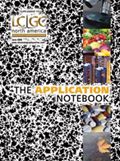
Pick Your Poison. Isolation of Paclitaxel (Mar 2025)
March 7th 2025The diterpenoid, paclitaxel, which was identified as a potent chemotherapy agent for breast and ovarian cancer originates from the Pacific Yew tree. The isolation of paclitaxel from its major impurities is shown with the use of Hamilton’s PRP-1 (5 µm) HPLC column.
















